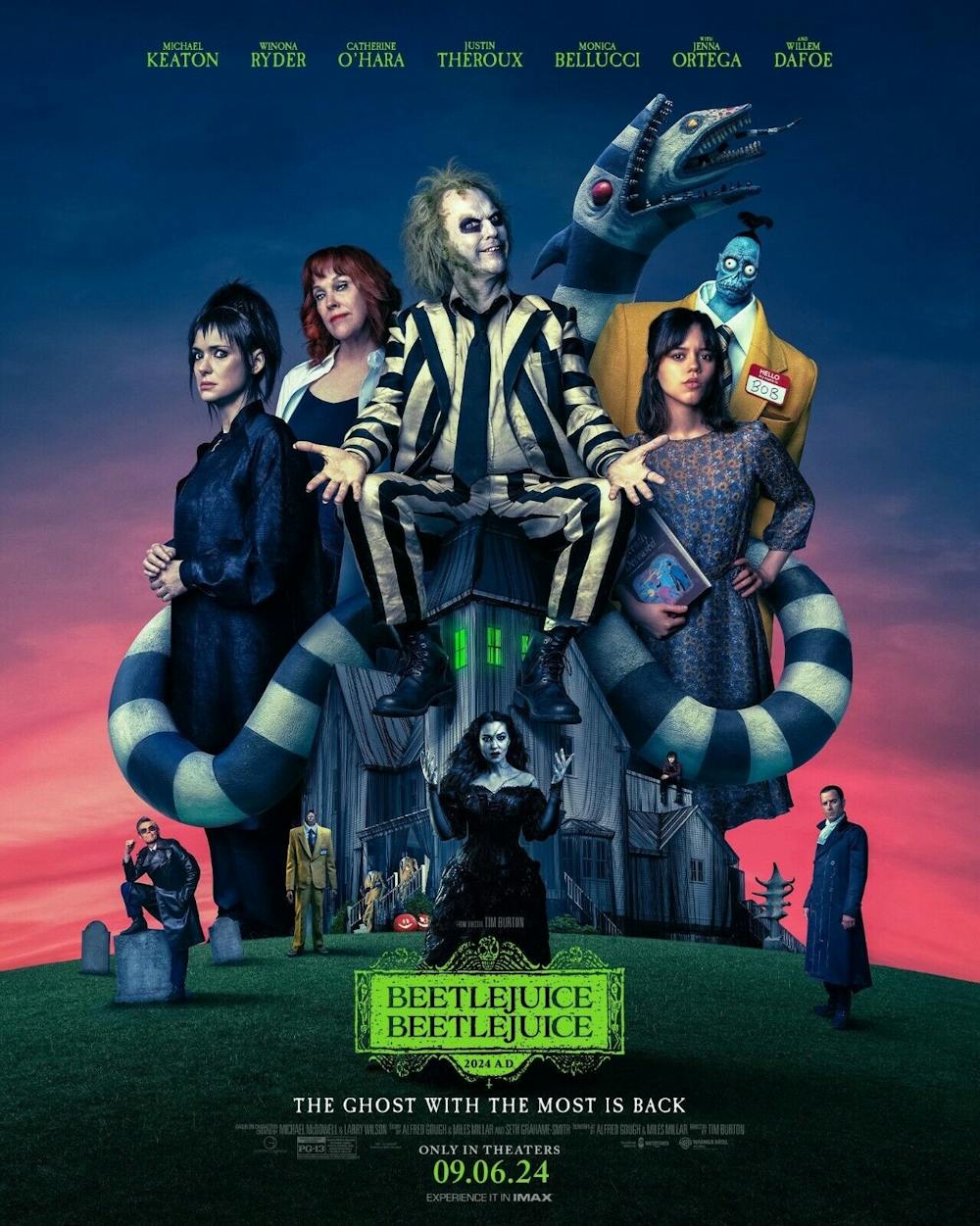Warner Bros., a notorious graverobber of pre-existing IP, has brought its 1988 cult favorite “Beetlejuice” back to life in an outlandishly amusing sequel, “Beetlejuice Beetlejuice”. So long as Hollywood continues in its tradition of extending franchises, thankfully, a director with as much creative flair as Tim Burton is in on the scheme. “Beetlejuice Beetlejuice” manages to braid together corporate marketability with Burton’s signature quirk – a combination that marks a notable deviation from the trend of uninspiring sequels to beloved crowd favorites.
This Reel Critic, or should we say Reel Critics, is a slight departure from The Campus’s regular programming. We – Nicky, Joseph and Catherine – are offering our three perspectives on the same viewing of “Beetlejuice Beetlejuice” to discuss the efficacy of the film as a sequel. None of us have viewed the original in recent years, so if Warner Bros. is hoping to usher in the next generation of “Beetlejuice” fans, we’re apt judges of their mission’s success. With our respective tastes and outlooks, we hope to shed light on the value of “Beetlejuice Beetlejuice” in contemporary times.
The film brings Beetlejuice (Michael Keaton) back from the dead to lust after Lydia Deetz (Winona Ryder) as she and her rebellious daughter Astrid (Jenna Ortega) cope with family tragedies. Lydia is a TV personality made famous for her psychic ability to communicate with the dead — she, like Burton, brings a Goth sensibility to the mainstream with a knowing wink. That is until she begins seeing visions of Beetlejuice and realizes their paths must cross again. Antics, entanglements and sidequests ensue; subplots abound, and characters both old and new blaze paths through Burton’s ever-expressive story world.
We soaked in the magic of Burton’s sequel from Middlebury’s-own Marquis, where the main theater was packed with moviegoers of all ages. For Nicky, her experience watching “Beetlejuice Beetlejuice” was beautifully flavored by the venue: she was sandwiched in the middle of an old leather couch with eight people, one elbow getting greasy in a bucket of popcorn the other jabbing a friend's midsection. She ate all of her candy during the previews then regretted it for the entirety of the movie which she spent half paying attention to and half considering the 70 acquaintances watching alongside us.
Indeed, it was hard to ignore the shared excitement that buzzed throughout the audience and the room was exceptionally responsive to the character of Delia Deetz (Catherine O’Hara) which we can only imagine implied a Schitt’s Creek fan stronghold. O’Hara was the standout comedian of “Beetlejuice Beetlejuice” in her portrayal of an overwrought artist with a flair for the dramatic, a perfect reawakening of her original character. Her performance complemented Ryder’s pretty, pale and paranoid sensibilities and Ortega’s angst and self-assurance. Keaton wholly delivered on his role as a campy villain and helped the film’s various plots tonally cohere.
For fellow audience member and Little Seed lead barista Stefan Eisler, “Beetlejuice has the aesthetics of an acid trip but it’s paired with the adventure of being stuck in a waiting room,” wrote Eisler in a message to The Campus. “I’m assuming it was all fanfare and that other Burton movies have more thrill.”
The three of us agree that while “Beetlejuice Beetlejuice”’s plot felt stale, the production design was well worth the price of admission. To Nicky, what the film may be lacking in substantive plot it makes up for this with an energizing score, sparkling costumes and sets and a lovable troop of suited-up skeletons with shrunken heads getting into all sorts of trouble. For Joseph, the production design was vivid and exciting with every costume choice and set piece being clever and immersive. And to Catherine, it could not have been more refreshing to watch a film that relied so heavily on human-made props, puppets, makeup, and costuming instead of software-created visual effects.
Burton certainly marinates in his artistic roots to great effect. There are epic scenes like when a children’s chorus performs Banana Boat “(Day-O)”, when the original “Beetlejuice” house is shrouded in black gauze, and a wonderfully surrealist dance sequence. These moments are so aesthetically powerful that many plot points feel obligatory as if the storyline is a gesture toward a narrative structure rather than what Burton’s audience came to see. And honestly, he’s not off-base. Because “Beetlejuice Beetlejuice” is so reliant on the appeal of its mise-en-scene, the plot is easily understandable for new viewers who might be unfamiliar with the original film. Not to mention, “Beetlejuice Beetlejuice” has a great sense of humor. Unlike many washed-up franchise films that pig on callbacks and references to earlier works, “Beetlejuice Beetlejuice” doesn’t indulge in fan service without letting everyone in on the gag.
Without requiring much prior homework to enjoy, “Beetlejuice Beetlejuice” is a refreshing departure from the modern sequel-ification of cinema. The film’s authenticity prevails even while trying to balance its idiosyncrasies with a studio design.
Catherine Goodrich '24 (she/her) is a Senior Arts and Culture Editor.
Catherine previously served as an Arts and Culture editor and Staff Writer. Catherine is an English and Film double major hailing from Birmingham, Alabama. She is the prose editor for the Blackbird Literary Arts journal and works concessions at the Middlebury Marquis where she has developed a love for trivia and making nachos.




